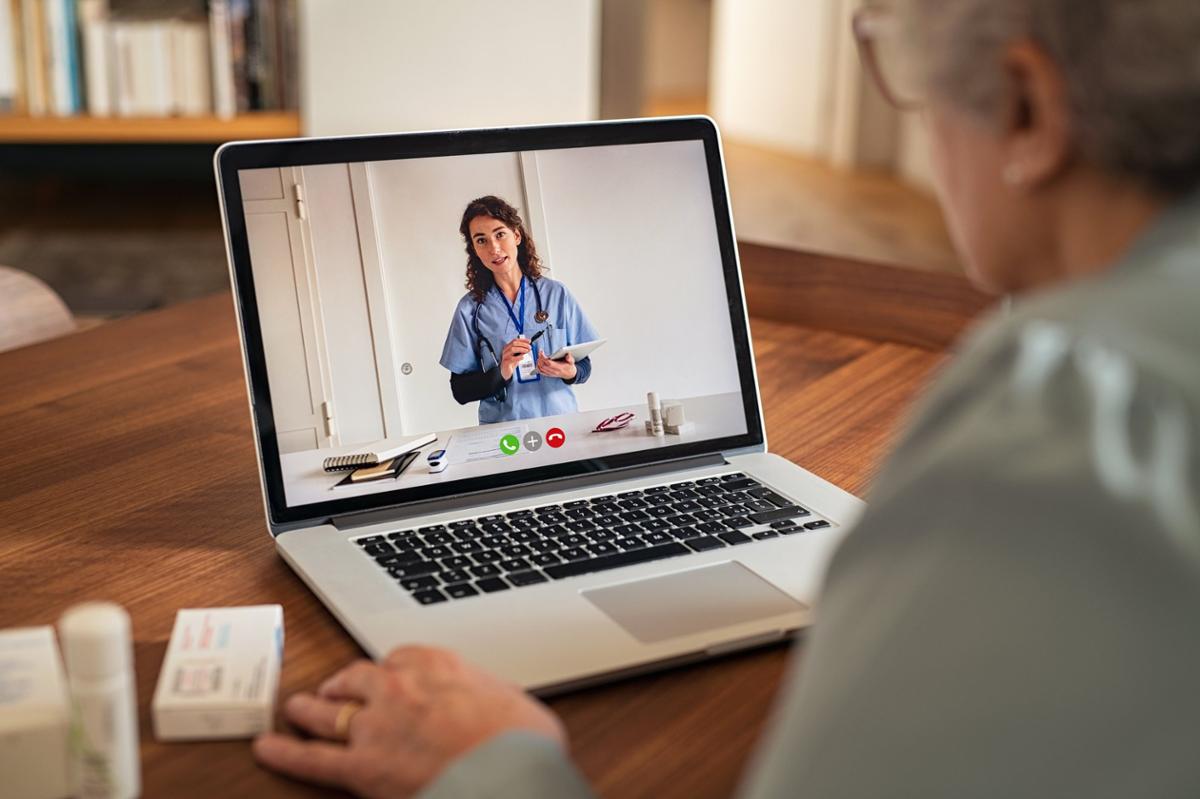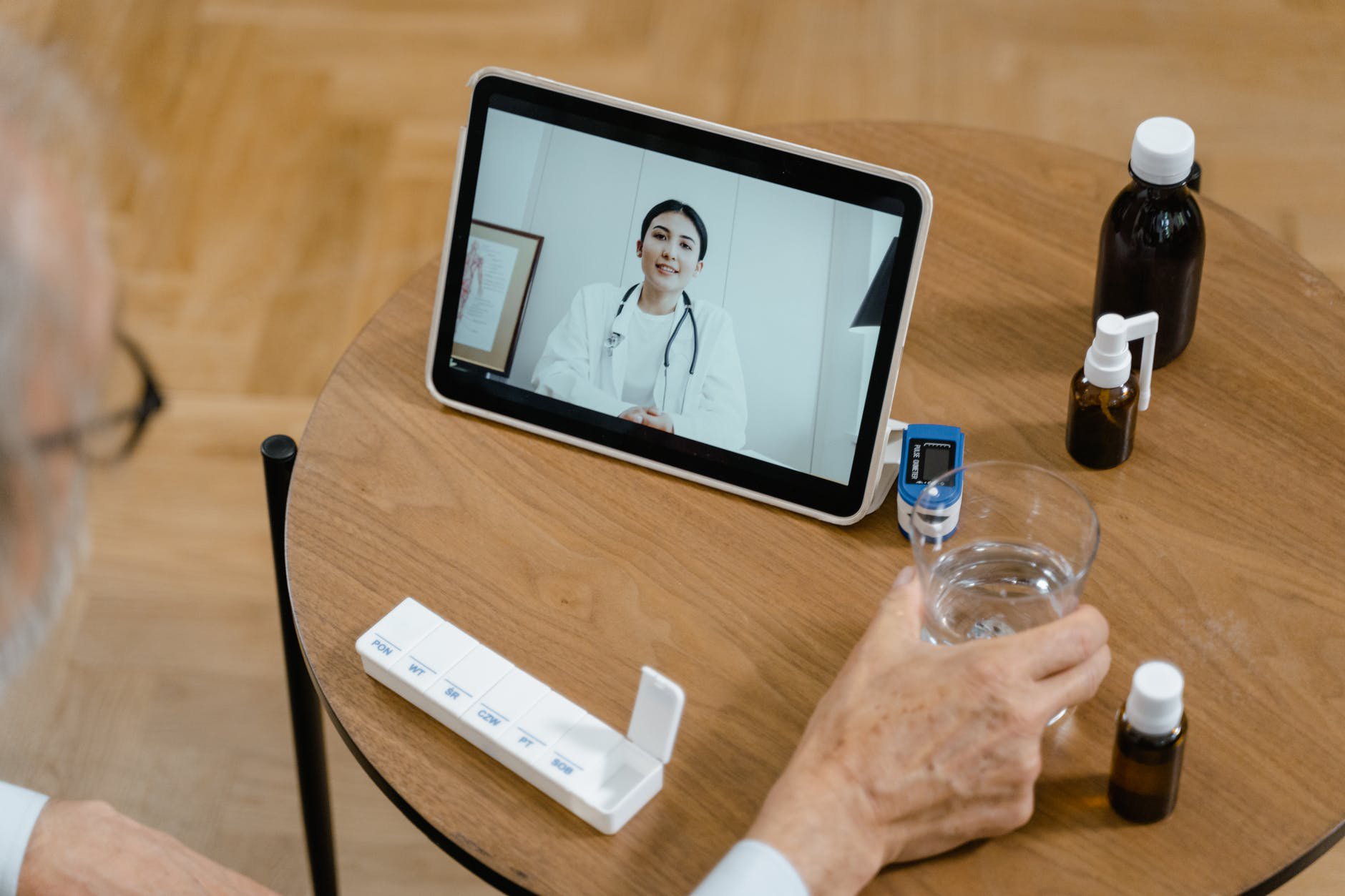Competent Care One Call Away: Everything You Need to Know About Telehealth Nursing

While the idea of telehealth nursing is not a novel concept, it has been steadily gaining more traction during the past few decades. It manages to improve care efficiency and increase patient access to medical services, making it an invaluable tool in the health management field.
Telehealth nursing is more than just responding to a telephone call or a video conference inquiry. It’s a way for Registered Nurses to use technology to everyone’s advantage: their own, the patient’s, and the entire healthcare system’s. The demand for telehealth nursing has risen even more due to the Covid-19 pandemic.
If you’ve ever considered a career in telehealth nursing, now is the best time to pursue it. Why is the popularity of telehealth nursing only growing? What are the benefits, as well as the disadvantages of engaging in this line of work? In this guide, you’ll find out everything you need to know about being a Telehealth Nurse.
What is Telehealth Nursing?
A definition might help pave the way for a better understanding of what telehealth nursing actually is.
From Greek, the prefix “tele” means over (at) a distance. When taken together, tele+health essentially refers to offering healthcare services from a different location – or at a distance – from where the patient is.
Simply put, telehealth nursing is a way to use telecommunications and other electronic and digital technologies to deliver nursing care remotely. The same job is also known by names such as telenursing or nursing telepractice. However, do not confuse it with telemedicine. While both refer to providing some type of healthcare services whenever physical distance exists between the patient and the professional, telenursing is only a component of telemedicine.
The technologies used in telenursing to bridge the distance between nurse and patient usually fit in three major categories:
- Live video conferencing. This is the most used type of technology in telehealth nursing. Usually, virtual visits with a telehealth nurse involve either a telephone or video call. Live video conferencing resembles more face-to-face interaction, making the experience of seeking help more comforting for the patient. This instrument acts as a preliminary stage. It’s used to examine the patient and see if their condition calls for an in-person visit, help a patient prepare for an operation, or follow up on an in-person visit to the doctor’s office.
- Store-and-Forward. Unlike live virtual visits, this telehealth instrument doesn’t necessarily require real-time interaction. Instead, it uses secure servers and channels to capture, store, and transmit essential patient data. These can include photographs of a patient’s symptoms, X-Rays, documents, and so on. For example, the patient can take a picture of the thing that’s bothering them (a rash, a mole, a wound, etc.) and send it to the doctor’s office. Next, the healthcare professionals, doctors, or nurses will respond and help the patient with their issue. Also, this technology makes inter-department communication and consultation easier, ensuring higher quality care for the patient.
- Remote Patient Monitoring is crucial as it allows Telehealth Nurses and other healthcare professionals to gather data about a patient’s condition. Different wearable technologies, such as medical devices, sensors, or healthcare apps, monitor and wirelessly transmit data to the appropriate clinicians. Such data may include blood pressure, heart rate, glucose levels, and other health statistics. RPM technologies allow telehealth nurses to observe changes in a patient’s condition and intervene before more severe complications occur.

What Is a Telehealth Nurse?
Registered Nurses or Nurse Practitioners generally offer telehealth nursing services. Their central role is providing high-quality care to patients through technologies that allow for remote interaction, such as phone, video, email, or messaging apps.
A Telehealth Nurse will generally assist patients with their minor problems. By carefully listening and observing, telenurses decide if the caller requires emergency care, if they need to schedule an appointment with a physician, or if they can administer their own treatment at home.
As a Telehealth Nurse, you can sometimes pursue a more specialized role. For instance, as a labor and delivery telenurse, you will mostly be called by pregnant women regarding potential labor symptoms and fatal well-being. Emergency Department nurses are more likely to receive calls about people experiencing illness symptoms or suffering from injuries.
Where Do Nurses Practice Telehealth?
One of the main selling points of a telehealth nursing job is that you can do it from virtually anywhere. As long as there is a reliable internet connection and access to the appropriate technologies, it can serve as a telehealth location.
That means that Telehealth Nurses work in a variety of settings. Most often, they work from home or an established triage center. However, keeping their specialization in mind, Telehealth Nurses can also find employment in other settings, like:
- Physician’s office
- Hospital
- Clinics
- Trauma center
- Prisons
- Crisis hotlines
- Outpatient care facilities
Depending on where they work, RNs can answer questions and guide patients. If they have access to the right tools, they can monitor a patient’s oxygen levels, heart rate, blood glucose, and more.
There are regional, statewide, and hospital contact centers where nurses can work. In some workplaces, access to telehealth nursing will be available around the clock, seven days a week.

What Does a Telehealth Nurse Do?
Being a Telehealth Nurse is no easy job. The job responsibilities are complex, and they can vary from helping a person calm down to assisting in life-threatening situations by dispatching an ambulance. Some of the more common duties and responsibilities include:
- Making use of their expertise, clinical algorithms, and protocols to assess the caller’s health status and symptoms carefully
- Offering medical advice to patients experiencing minor health issues
- Scheduling appointments with the appropriate clinical specialists
- Ensuring the patient is educated and knows how to manage their symptoms at home.
- Monitoring patient’s data via Remote Patient Monitoring technologies
- Offering pre-op and post-op nursing care
- Offering support to medical support teams dispatched to bring patients to the hospital
- Evaluating outcomes
One of the main aims of telehealth nursing is reducing the number of trips to the ER, thus reducing patient load.
How to Become a Telehealth Nurse?
Telehealth’s growing popularity is undeniable, and its benefits multiple. So, you may find yourself wondering how to get into this career. To become a Telehealth Nurse, you’ll have to complete the next steps:
- Attend nursing school. You can either opt for an ADN or BSN program. However, healthcare employers increasingly prefer BSN-trained nurses.
- Pass the NCLEX RN exam. Having an unencumbered RN license is the minimum requirement to become a Telehealth Nurse. And as you already know, passing the NCLEX is the last step towards becoming an RN.
- Gain first-hand experience. Before you can transition into a telenursing role, you’ll need to have some nursing experience. You may have to gain anywhere from 2 to 5 years of bedside expertise before you can reap the benefits of a telehealth nursing position.
- Earn certification. It’s important to mention that there is no specific Telehealth certification. Because telehealth nurses often provide care to patients in ambulatory care settings, obtaining the Ambulatory Care Nursing Certification has become the norm for aspiring telehealth RNs.

What Skills Are the Most Important for a Telehealth Nurse?
In addition to extensive knowledge and clinical expertise, some skills are invaluable to Telehealth Nurses:
Critical Thinking is of utmost importance. Telehealth RNs must systematically decide how serious of a medical problem the caller describes. Can they be helped at home, do they need to be referred to another specialist, or is an in-person visit required? They also need to know when to ask for more in-depth details about the symptoms and must interpret the information quickly and efficiently.
Excellent listening skills are one of the main building blocks of a telehealth career. Without the possibility of physically examining the patient, you rely almost entirely on what the patient tells you. So, you must listen carefully, visualize what they’re sharing, and know when to probe further to provide an accurate assessment.
Great communication skills are another essential skill for Telehealth Nurses. Building a rapport with the caller, directing them to accurately describe their symptoms or problems can make the difference between life and death. Communication skills are essential to get your knowledge and all the relevant information across. When the patient hangs up the phone, they need to have understood you wholly and thoroughly. A study asked patients what would encourage them to book a telemedicine appointment. Over 57% of participants mentioned communication as a defining factor.
Continuous desire to develop their skills and knowledge cannot be understated. Telehealth nursing is a continuously evolving field, so you need to keep up with it. Technology is advancing quickly, so the willingness to learn is paramount to keep up with the pace.
A combination of training, education, and sharpening these skills is bound to make you a successful Telehealth Nurse.
What Is the Salary and Employment Outlook for Telehealth Nurses?
While there is no official data regarding Telehealth Nurse salaries, according to the job platform ZipRecruiter, the average salary of a Telenurse revolves around $72,200 a year.
Telehealth nursing is here to stay, with jobs quickly growing and evolving. So, in terms of employment outlook, Telehealth Nurses enjoy fantastic career opportunities. Some projections indicate that the global telehealth market will reach $55.6 billion by 2025. In the United States, the American Telemedicine Association mentioned that half of US hospitals have already implemented some type of telemedicine. At the same time, 90% of healthcare executives have committed to developing and implementing a telehealth program.

What are the Benefits of a Telehealth Nurse?
Multiple studies have shown that the benefits of telehealth nursing extend to all levels of the healthcare system.
First off, telenurses can assist with patient retention, and their contribution helps decrease on-call hours for healthcare providers. Secondly, the very nature of the job allows for telehealth nurses to be available 24/7, even during the weekends or after hours.
While the advantages of telehealth nursing are far more numerous, we have identified five major areas in which telehealth is a real game-changer:
1. Ensures increased access to healthcare services
Telehealth RNs are a blessing, especially for vulnerable populations and people living in rural areas, where the healthcare disparities are striking. Healthcare providers are hard to come by in these situations, with many being situated many hours away. Thus, telehealth services can help bridge the distance between patients and the necessary medical help, reduce transportation costs and ensure convenient and timely healthcare access.
Telehealth nursing may also be the answer in many crises. When getting to a patient is challenging, telehealth nursing may be the way to help people with minor injuries and avoid more tragedies after a natural disaster strikes.
2. It saves time and money
Telehealth nursing improves access to healthcare by saving the patients a lot of time and money. Opting for a nursing telehealth service helps the patient avoid waiting long periods to schedule an in-person appointment, miss work, pay transportation costs, arrange for childcare, or face other obstacles.
There are no shortage of studies showing that telehealth nursing has an essential role in saving on medical costs and referrals. For example, a person who’s only experiencing mild symptoms or only facing a minor health issue might avoid an expensive trip to the ER by first calling a nurse assistance line.
Also, telemedicine generally saves patients around 100 minutes of their time compared to an in-person visit. No time is wasted waiting in traffic or waiting in line at the doctor’s office. Plus, the appointment is made from the comfort of their home.
It also saves time and money for medical institutions and their staff. Hospitals spend more than $26 billion every year just on re-admissions. That is because many patients don’t follow the appropriate steps once released from the hospital. Here is where telehealth can be beneficial. It makes it easier for patients to connect with nurses and keep their recovery process in check, diminishing the need to go back to the hospital, which can be as financially draining as it is frustrating.
One study showed that participants in a behavioral health intervention telehealth program had 31% fewer hospital admissions and stayed in the hospital 48% less time than patients who didn’t participate in the study. This translates into money saved for both the patient and the medical institution.
3. More flexible nurse schedules
The benefits of telenursing extend to nurses, as well. The job offers the possibility of working from home and having flexible hours – a great advantage for nurses who are seeking to improve their work-life balance.
Registered Nurses, in general, have to juggle more responsibilities, from clinical to administrative and caregiving. Telehealth gives nurses tools to better balance their work schedules. Lowering re-admission numbers also impacts nursing workloads, permitting RNS to devote more attention to patients who need it most.
4. Better educated patients
Managing chronic conditions, following post-surgical care procedures, and keeping your post-discharge state in check is now easier than ever with the help of telehealth nursing. RPM technologies, live video conferencing sessions, and virtual checkups make it easier for patients to manage their conditions from home successfully. Telehealth Nurses are always one phone call away to offer them advice, feedback, or instructions. So, especially for patients with chronic conditions like diabetes or COPD, many routine in-person visits can be replaced by Remote Patient Monitoring technologies and telehealth nursing.
The same goes for parents who worry about their child’s symptoms and want to consult someone before deciding if an ED visit is the appropriate response. One call with a telehealth nurse can clarify if the situation is worrisome or if the parent can ameliorate it at home. So, in the long run, this is beneficial for both the family and the healthcare system. The parents get educated on caring for their sick children at home while the hospital avoids overcrowding. The support, confidence, and encouragement Telehealth Nurses offer is beneficial for everyone.
5. Decreases likelihood of being exposed to illnesses
This is equally important for nurses and patients. A telephone call or video call can limit the patient’s exposure to dangerous illnesses, viruses, and so on. This was particularly applicable in the case of the Coronavirus. Opting for telehealth (when possible) was a way for patients to protect themselves, their community, and the healthcare staff from contracting the virus and suffering the consequences.
Are There Any Disadvantages to Telehealth Nursing?
Although the benefits far outweigh the shortcomings, even telehealth nursing has some disadvantages.
No matter how much the technology evolves, some appointments and check-ins will still happen in person. Not all problems can be solved via a video conference, and not all symptoms manage to break the technological wall.
Also, there’s a matter of access to care, and some patients may experience specific barriers in this regard. For example, patients who don’t have a phone or access to an internet connection cannot benefit from nursing telehealth services.
There also may be an issue of reimbursement. While most states have parity laws requiring insurance companies to reimburse for telehealth services, that’s not always the case. So, telenurses must keep an eye out for regulations and insurance plans in the area where they practice.

How Has Covid-19 Changed The Face of Telehealth Nursing?
While the concept of telehealth isn’t new, its reach and impact have changed significantly due to the pandemic.
According to a report from the Centers for Disease Control and Prevention (CDC), there was a 154% increase in telehealth visits in March 2020 compared to the same period of the previous year. Also, to permit easier access and delivery of care, many states have changed their laws. For instance, before nurses licensed in North Carolina could only treat patients from North Carolina. Due to the pandemic, the reach was expanded, and they could also care for patients from South Carolina and Georgia.
During the pandemic, the need for telehealth has increased exponentially. Telemedicine-related technologies and telehealth professionals played a vital role in gathering information, reassuring the population, and treating patients.
Telehealth has proven so valuable during the pandemic for several reasons. It expanded people’s access to healthcare, reduced the nurses’ exposure to disease, lowered the need for personal protective equipment, and allowed more patients to be cared for by one medical institution.
It also enabled older adults, people with disabilities or other pre-conditions, and residents of remote areas to gain access to essential nursing services virtually. Thus, it limited unnecessary exposure to the virus and other illnesses.
What’s Next in the World of Telehealth Nursing?
Healthcare is changing rapidly, and the outspread of telehealth nursing is just one way in which the digital age is impacting health services.
Smartphones, the Cloud, web portals, portable devices, biosensors, and many other technological instruments are already making telehealth a secure, fast, and convenient way to seek help. They managed to shorten hospital stays, lower readmission rates, monitor chronic health problems, grant people more access to quality health services. The American Telemedicine Association even predicted that more than half of all healthcare services will be consumed virtually by the end of the decade.
That’s why competent, professional, well-trained Telenurses are a principal part of the healthcare system. And that’s why the job is only going to grow in the years to come.

Are You Ready to Embark on the Telehealth Nursing Journey?
Telehealth nursing is an amazing career opportunity. It offers the possibility to work from home, comes with more flexible working hours, and paves the way for a better work-life balance. Not to mention the rapidity at which the field is growing and the potential for impact that Telehealth Nurses hold.
And the first important step to reaping all these benefits is getting your Bachelor’s Degree in Nursing. A BSN will propel you forward in your career and put you on the path to a successful and rewarding career in telehealth nursing.
The future’s looking bright. Are you ready to go after it?

